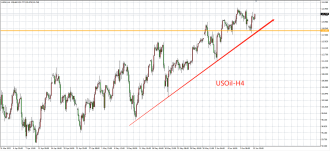As the U.S. CPI again exploded to a 40-year high last week, the market’s expectations for the Fed to raise interest rates surged sharply, and sentiment deteriorated sharply. The first day of the week ushered in “Black Monday”, triggering a sharp drop in global bond markets and a sharp decline in the U.S. The currency that has benefited the most from the sharp rise in bond yields - the US dollar hit a new high in 20 years, all other assets, whether risky or safe-haven, all fell, and the three major US stock indexes all fell by more than 3%; all non-US currencies fell under pressure; Under the impact of the US bond yields breaking new highs, gold fell by more than 50 US dollars in a single day; Bitcoin also plummeted by more than 10%; only crude oil with a good supply and demand side performed tenaciously and closed up tenaciously.
Fed rate hike expectations soar, markets shaken
Investors are worried that the Fed will have to significantly tighten policy to control inflation. According to CME's "Federal Reserve Watch", the probability of the Fed raising interest rates by 75 basis points by June has soared to 69.4%; at the same time, according to the Wall Street Journal, high inflation may make the Fed This week's rate hike was larger than expected, with Fed officials likely to approve a 75 basis point hike. Fed swaps show a 76.6% chance of a 75 basis point rate hike by the Fed in June, with the Fed's endpoint rate at 4% by mid-2023.
After the CPI data, Goldman Sachs has revised the Fed's interest rate hike expectations, believing that the Fed will raise interest rates by 75 basis points in June and July; JPMorgan Chase expects the Fed to raise interest rates by 75 basis points this week, saying that the Fed may "make Unexpected" - 100 basis points of interest rate hike; Standard Chartered Bank expects the Fed to raise interest rates by 50 basis points in June, but does not rule out the possibility of raising interest rates by 75 basis points or 100 basis points; Bank of America and KfW still expect the Fed to raise interest rates 50 basis points.
In fact, after the release of inflation data last week, major institutions have revised their policy expectations for the Fed. Goldman Sachs expects the Fed to raise interest rates by 75 basis points in June and July, and by 50 basis points in September. And December will raise interest rates by 25 basis points, until the end of 2022, the neutral rate will reach 3.25%-3.5%; JPMorgan Chase expects the Fed to raise interest rates by 75 basis points this week.
In the current situation, investors' expectation for the Fed to raise interest rates is not only 75 basis points, but has even risen to 100 basis points. This re-substantial pricing has caused a huge shock in the market. The US dollar index broke through 105, a 20-year high since 2002. At the same time, U.S. bond yields rose above 3.40%, hitting a new high. In the process of market re-pricing, the risk of economic recession further increased. The VIX panic index soared by 26% during the session, and non-US currencies, gold, Bitcoin, US stocks and other assets all fell.
It is worth noting that on Monday (June 13), the yield on the two-year U.S. Treasury bond was higher than the yield on the 10-year Treasury bond for the first time since the beginning of April. Higher short-term yields than long-term yields are seen as the economy may be facing a recession. JPMorgan sees the current risk of a recession in the U.S. economy at about 50%. Fitch believes U.S. economic growth will slow to a barely positive quarterly rate from mid-2023 due to more aggressive monetary tightening. And U.S. economic growth is expected to fall to 1.5% in 2023 and 1.3% in 2024.
How long can oil prices stay high?
At a time when risk assets were generally under pressure and fell, oil prices remained exceptionally strong. WTI crude oil continued to return above $120 after a brief correction, indicating that the supply and demand side is still the main factor affecting oil prices.
Coincidentally, according to market reports, the Libyan Minister of Oil and Gas said that almost all oil fields in the country, except the Hamada oil field and the Mellitah oil plant, have ceased operations, resulting in a drop in Libyan oil production by more than 1 million barrels per day.
On the supply side in general, although OPEC increased production to 648,000 barrels per day in July and August, the increase was only 0.4% of global oil demand. After the EU officially announced the sixth round of oil sanctions against Russia, the market expects that Russia's supply gap will increase to 1.5 million barrels per day, which means that the global oil market will still find it difficult to get rid of the demand exceeding supply in the event of a deadlock in the Iran nuclear deal. Happening.
However, there are still many unknown risks in the oil market. With the major central banks adopting a new round of more aggressive monetary policies, the risk of economic recession will eventually be reflected in demand. In addition, Saudi Arabia and the United States still have a lot of room to increase production. The room for further upward movement of oil prices is limited, and one should be alert to the possibility that the outbreak of systemic financial risks will eventually drag down oil prices.
Investors in the market outlook can pay attention to the situation of US President Biden's visit to Saudi Arabia. If Biden visits Saudi Arabia, it is not ruled out that Saudi Arabia will increase the supply of oil. Once Saudi Arabia and the United States jointly increase production, the risk factor for the current high and shaky oil price is self-evident.
WTI crude oil is in a multi-cycle upward trend. From the 4-hour chart, oil prices are expected to continue Zhang's continuation before the upward trend line ($118) is broken. It does not rule out the formation of a short-term top, and the market may enter a shock or start a new round of callbacks, and the next support area will be around $115-112.
 2022-06-14
2022-06-14
 1174
1174







 简体中文
简体中文
 ภาษาไทย
ภาษาไทย
 繁體中文
繁體中文
 Indonesia
Indonesia











